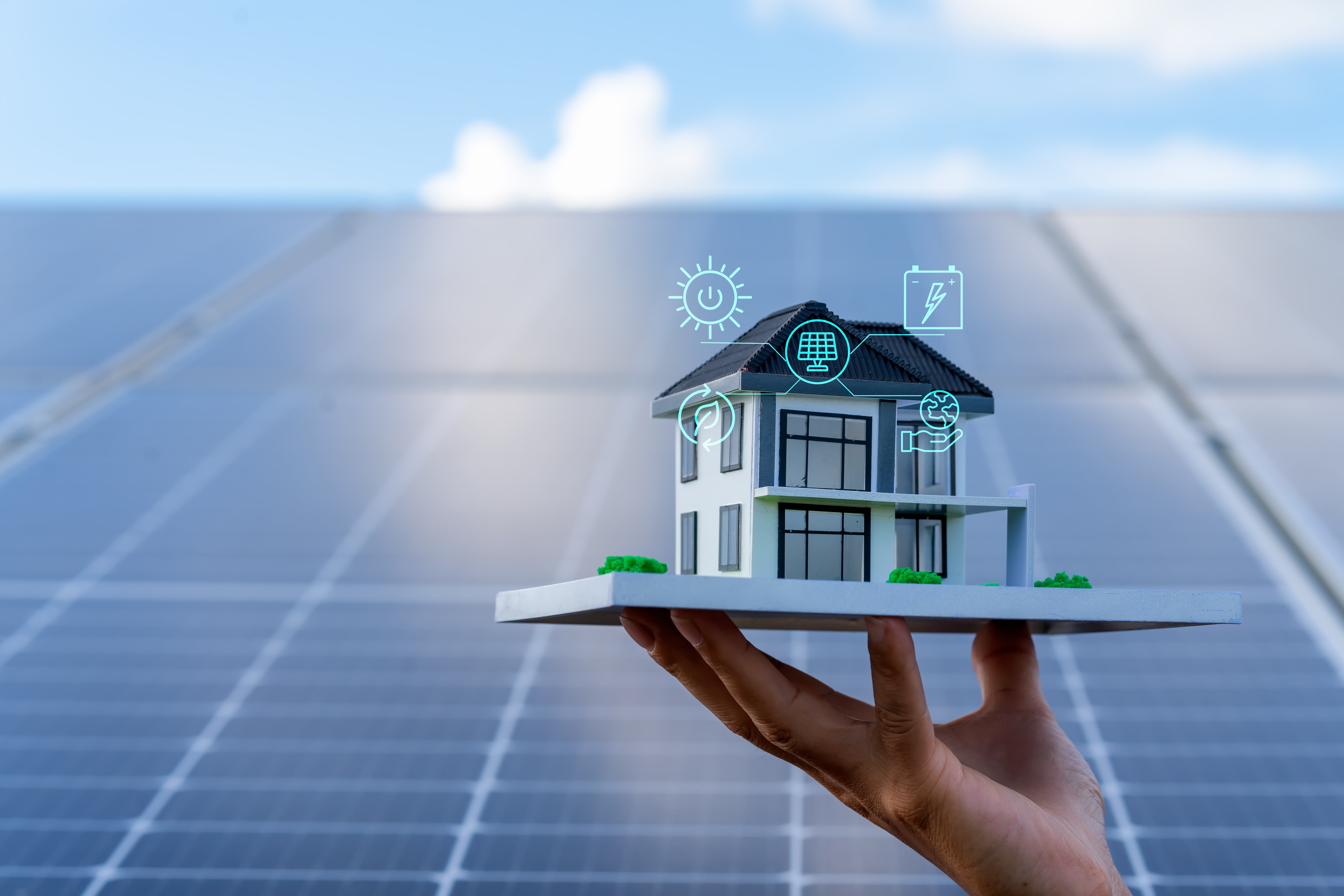Slay Your Home's Energy Vampires
Wasting money on energy vampires? You have the power to save money and energy in your own home with these 8 tools and tricks.


Jeff Bertolucci
The average household spends about $2,200 annually on energy bills. Although most of that expense is just the price of owning a home, it also includes the impact of a bunch of energy wasters, or energy "vampires," if you will. Fortunately, there are several tools and tricks that can help reduce your home's energy use and reduce your carbon footprint — that's good for you and the planet.
Simple things like leaving appliances plugged in or not changing the filter on your HVAC unit can cost you a fortune each year. The good news is that there are money-saving ways to cut down on your energy bills. From turning down your thermostat to insulating your windows, here are 8 simple tools and tricks to help you save money and kilowatts.
1. Turn down the thermostat
One of the easiest ways to save on your household energy bill is to simply turn down the thermostat. According to energy.gov, If you turn the temperature down for more than 8 hours at a time, you can save up to 1% on your energy bill per degree, without giving up a warm and cozy home. You might want to also invest in a smart thermostat to trim your utility bills while keeping your home comfortable.

Sign up for Kiplinger’s Free E-Newsletters
Profit and prosper with the best of expert advice on investing, taxes, retirement, personal finance and more - straight to your e-mail.
Profit and prosper with the best of expert advice - straight to your e-mail.
You can schedule your smart thermostat to tell you what temperature you want and when, control the temperature in a particular room, see exactly how much energy you’re using and automatically adjust the settings based on your habits, saving you money.
2. Insulate your windows
In an average home, windows can occupy about 15% to 20% of the surface area of the walls. During colder winters, heat can escape through gaps in your windows, especially if they are older or in bad shape. To ensure this doesn't happen, use a draft stopper, cover your windows with window insulation film, and add weather stripping or heavier, thicker window coverings designed to keep cold air from getting into your home through windows.
3. Switch off unnecessary appliances
A simple step to save household energy is to unplug cell phones and MP3 players once they're charged. Turn off the lights when you leave the room, and unplug appliances you're not using, especially when leaving for an extended vacation. You can also switch out regular light bulbs for LEDs, which are cheaper to run and will significantly reduce energy use.
4. Don’t overload your washing machine
You may think you're saving energy by piling as many clothes as you can get into your washing machine, but in reality it's working harder to wash a heavy load, and is using much more energy (and water) than necessary. Similarly, don't overload your dryer. You also won't have to repair or replace your washer and dryer as often — a win-win for your budget.
5. Change HVAC filters
Because the average person in the U.S. spends 90% of their time inside, indoor air quality can have a significant impact on your overall health, and your wallet. When an HVAC filter is clogged, it has to work harder for longer periods of time, which increases the energy your home uses. Cleaning the filters on your furnace and air conditioner will not only save you money, but also keep your family healthy. Besides, its a quick and painless process that can be done in less than an hour.
6. Insulate your attic
Poorly insulated walls and attics siphon heat and cold from our homes. Although there are many different types of insulation, make sure the R-value (a number that shows the effectiveness of the insulation) is right for the size of your attic. Colder climates should have insulation with a minimum R-value of 49. Houses in warmer climates should have an R-value of 30, according to the U.S. Department of Energy.
7. Shop for energy-saving appliances
Look for home appliances, such as microwaves and cordless phones, with low standby-power ratings. The Web site for the Federal Emergency Management Agency's Standby Power Data Center can tell you how much energy a device uses when it's idle. Just enter a product type, model number, or company or brand name, and the FEMA Center database will reveal which of the products meet the agency's standby-power requirements.
8. Don't leave electronics on standby
Leaving your electronic devices on standby can drain nearly 10% of your homes energy use, according to the Lawrence Berkeley National Laboratory. When electrical appliances, "energy vampires," are plugged into an outlet, they use energy even when turned off. To save money, unplug all large and small electrical appliances, such as your computer, cable box, coffee maker, microwave, printer, television and toaster.
If you're truly on a crusade to hunt down energy wasters and cut your energy bill, you'll need a measuring tool. Consider an inexpensive energy monitor such as P3 International's Kill A Watt EZ. Priced at about $31, this handy device plugs into a wall outlet. Connect an appliance to the Kill A Watt, and it will measure how many kilowatt-hours of energy are being used and estimate how much the appliance costs to operate.
Related Content
Get Kiplinger Today newsletter — free
Profit and prosper with the best of Kiplinger's advice on investing, taxes, retirement, personal finance and much more. Delivered daily. Enter your email in the box and click Sign Me Up.

For the past 18+ years, Kathryn has highlighted the humanity in personal finance by shaping stories that identify the opportunities and obstacles in managing a person's finances. All the same, she’ll jump on other equally important topics if needed. Kathryn graduated with a degree in Journalism and lives in Duluth, Minnesota. She joined Kiplinger in 2023 as a contributor.
- Jeff BertolucciContributing Writer, Kiplinger's Personal Finance
-
 The Best Places for LGBTQ People to Retire Abroad
The Best Places for LGBTQ People to Retire AbroadLGBTQ people can safely retire abroad, but they must know a country’s laws and level of support — going beyond the usual retirement considerations.
By Drew Limsky Published
-
 Financial Planning's Paradox: Balancing Riches and True Wealth
Financial Planning's Paradox: Balancing Riches and True WealthWhile enough money is important for financial security, it does not guarantee fulfillment. How can retirees and financial advisers keep their eye on the ball?
By Richard P. Himmer, PhD Published
-
 Best Places for LGBTQ People to Retire Abroad
Best Places for LGBTQ People to Retire AbroadLGBTQ people can safely retire abroad, but they must know a country’s laws and level of support — going beyond the usual retirement considerations.
By Drew Limsky Published
-
 6 Luxury Waterfront Homes for Sale Around the US
6 Luxury Waterfront Homes for Sale Around the USFrom private peninsulas to lakes, bayous and beyond, Kiplinger's "Listed" series brings you another selection of dream homes for sale on the waterfront.
By Charlotte Gorbold Published
-
 How to Get Apple TV Plus for just $2.99
How to Get Apple TV Plus for just $2.99For a limited time, you can get three months of Apple TV Plus for just $2.99 per month. Here’s how to get the deal.
By Rachael Green Published
-
 Don’t Panic About the “Retail Blackout” – See Which Stores Are Closing (and Which Aren’t) for Easter 2025
Don’t Panic About the “Retail Blackout” – See Which Stores Are Closing (and Which Aren’t) for Easter 2025Dozens of major retailers are planning to close their doors on April 20. Find out which of your go-to stores are on the list.
By Rachael Green Published
-
 Home Insurance: How to Cut Costs Without Losing Coverage
Home Insurance: How to Cut Costs Without Losing CoverageNatural disasters are causing home insurance premiums to soar, but don't risk dropping your coverage completely when there are ways to keep costs down.
By Jared Elson, Investment Adviser Published
-
 Why Homeowners Insurance Has Gotten So Very Expensive
Why Homeowners Insurance Has Gotten So Very ExpensiveThe home insurance industry is seeing more frequent and bigger claims because of weather, wildfires and other natural disasters.
By Karl Susman, CPCU, LUTCF, CIC, CSFP, CFS, CPIA, AAI-M, PLCS Published
-
 Zelle App Shut Down? Why Zelle Has Discontinued Its App
Zelle App Shut Down? Why Zelle Has Discontinued Its AppWith the Zelle app shut down, learn how you can still use Zelle and which other mobile payment apps you might want to consider.
By Paige Cerulli Published
-
 Six Best Places to Live in Florida
Six Best Places to Live in FloridaPlaces to Live Florida offers a range of cities where you’re never far from the sound of lapping waves.
By Drew Limsky Published